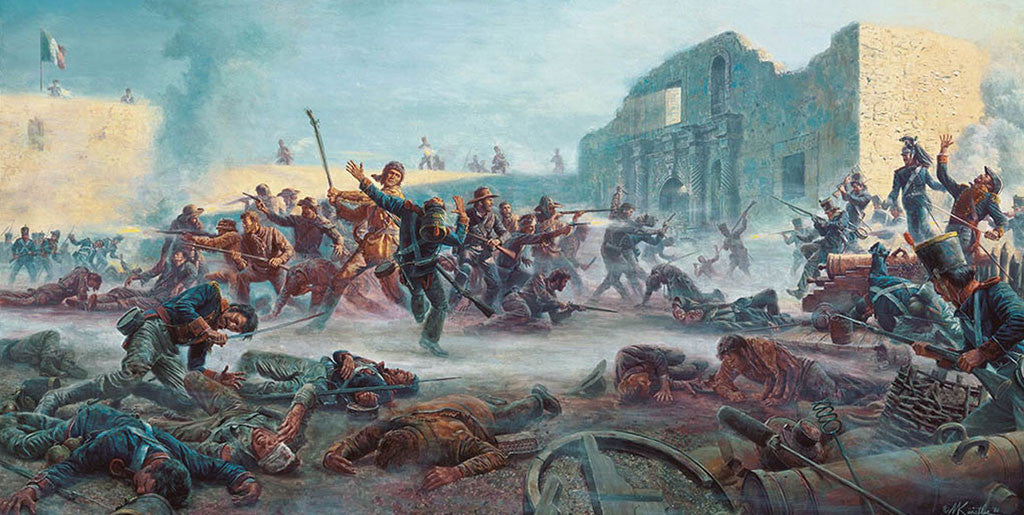
The Battle of the Alamo: A Texan Legacy
The Battle of the Alamo is the creation story of Texas. Few men so well embody true patriotism as the legendary assembly that stood in defense of the Alamo from February 23 to March 6, 1836. With a cast of characters larger than life itself, the Battle of the Alamo stands out in American history and continues to capture the imaginations of people around the world.
The standoff and predawn battle on March 6, 1836, generated countless stories of valor on all sides of the conflict, a pivotal event of the 1835-36 revolution that helped established Texas as an independent republic before U.S. statehood began in 1845. But we’re getting ahead of ourselves. Here’s what happened:
How the Alamo became the Alamo…
San Antonio de Valero Mission was originally built as a home to Spanish missionaries. Covering approximately three acres of land and surrounded by a wall nearly 12 feet tall, the fort held a chapel, a hospital room, a barracks and a horse corral. Basically, the perfect fortress for Spanish soldiers, which is what the plot of land eventually evolved into.
In 1803, a company of Spanish soldiers from Álamo de Parras, Coahuila, Mexico, used its buildings as barracks for a number of years. This is likely where the name “The Alamo” originated.
This is where things get interesting…
In 1821, Mexico won its independence from Spain. At the time, Texas was part of Mexico and many Americans had moved to Texas, thereby becoming Mexican citizens. But the relationship was soon to find itself on rocky ground.
In 1832, a powerful General named Antonio López de Santa Anna took control of the government. To say Santa Anna had a bit of an ego, is a supreme understatement. The man proclaimed himself the “Napoleon of the West,” and once held an elaborate state funeral for his amputated leg – but that’s another story.
After Santa Anna stepped in to run the Mexican government, things began to shift into an increasingly dictatorial manner – and many federalists along the border region of Mexican Texas (otherwise known as Texians), weren’t having it. Being accustomed to extensive individual rights, and having those rights threatened – well – that caused a bit of tension. Texians rebelled, organizing what would go down in history books as the Texas Revolution.
And so it began…
The first shot of the Texas Revolution was fired at the Battle of Gonzales on October 2, 1835. Over the next three months, Texian colonists, comprised of Texian troops, American Volunteers, and their Tejano (Texian of Mexican descent) allies, were able to defeat Mexican forces.
Needless to say, Santa Anna was infuriated.. He led Mexican troops into Texas to put an end to the resistance. Two forts blocked the Mexican approaches into Texas: Presidio La Bahía at Goliad and the Alamo at San Antonio de Bexar. Mexican General Jose Urrea marched half of the troops up the Texas coast in the Goliad campaign, while Santa Anna led the rest of the troops to San Antonio de Bexar.
The Siege of Béxar…
Texian troops rallied during the Siege of Béxar, and were able to drive off Mexican forces. Texian soldiers then moved quickly to establish a garrison at the Alamo, led by legendary pioneer James Bowie and Lieutenant Colonel William Travis. In all, there were approximately 200 Texian troops defending the Alamo, including Davy Crockett, a famous frontiersman, former U.S. Congressman, and the highest-profile defender of the Alamo.
Knowing that Santa Anna was continuing to gather men in alarming numbers, Travis wrote letters begging for men and supplies. Sadly, his requests were not met and approximately 200 exhausted and underfed Texians stood prepared (or some could argue unprepared) to take on an army of nearly 1,800 Mexican soldiers.
The Battle of the Alamo…
On February 23, 1836, General Santa Anna and his troops surrounded the Texas garrison in the Alamo. The siege of the Alamo lasted thirteen days. On day twelve, Santa Anna ordered a full-fledged assault for the following day, stunning his officers. With no Texian relief appearing and provisions running out, it would only be a matter of time before the rebels would realize surrendering was their only option.
Santa Anna sent a courier to demand that the Alamo surrender. While the Texian forces may have been undermanned and without provisions, they were not lacking in patriotism. Travis replied to Anna’s demand with a cannonball – some would say a pretty direct response.
And so, at approximately 5:00 a.m. on Sunday, March 6, Mexican forces hurled columns at the battered walls from all directions. Artillerymen set about knocking down the walls and storming the Alamo. Still, Texian gunners stood by their artillery to the very end. The assault lasted no more than ninety minutes.
As many as seven defenders survived the battle, though Santa Anna, a man who enjoyed having the final word, ordered their summary execution. Crockett's fate is unclear. Many historians and patriots count Crockett as a member of those seven, though the mayor of San Antonio, however, claimed to have seen Crockett dead among the other defenders. Either way, the man, the myth and the legend fought bravely and did not survive the Battle of the Alamo. By 8:00 a.m., every Texian Alamo soldier was dead.
Remember the Alamo…
Following the Battle of the Alamo, several non-combatants were sent to Gonzales to spread word of the Texian defeat. News of the Alamo's fall sparked feelings of nationalism and inspired a strong rush to join the Texian army, now led by the infamous General Sam Houston.
On April 21, 1836, the Texian army attacked Santa Anna's camp near Lynchburg Ferry. Spurred on by the battle cry “Remember the Alamo,” which loomed large in Houston’s and his troops’ minds, General Houston’s “800 men defeated a force twice its size in a mere 18 minutes.” The spectacular rout at the Battle of Battle of San Jacinto forced Santa Anna to surrender and sign an armistice that granted Texas independence. Needless to say, it was a ground-breaking day for Texas!
A Texan legacy…
Despite the great loss, the siege and final assault on the Alamo in 1836 is one of the most celebrated military engagements, recognized as a symbol of true patriotic sacrifice.



